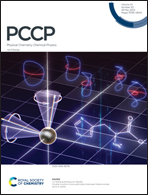Locally spontaneous dynamic oxygen migration on biphenylene: a DFT study†
Abstract
The dynamic oxygen migration at the interface of carbon allotropes dominated by the periodic hexagonal rings, including graphene and carbon nanotubes, has opened up a new avenue to realize dynamic covalent materials. However, for the carbon materials with hybrid carbon rings, such as biphenylene, whether the dynamic oxygen migration at its interface can still be found remains unknown. Using both density functional theory calculations and machine-learning-based molecular dynamics (MLMD) simulations, we found that the oxygen migration departing away from the four-membered carbon (C4) ring is hindered, and the oxygen atom prefers to spontaneously migrate toward/around the C4 ring. This locally spontaneous dynamic oxygen migration on the biphenylene is attributed to a high barrier of about 1.5 eV for the former process and a relatively low barrier of about 0.3 eV for the latter one, originating from the enhanced activity of the C–O bond near/around the C4 ring due to the hybrid carbon ring structure. Moreover, the locally spontaneous dynamic oxygen migration is further confirmed by MLMD simulations. This work sheds light on the potential of biphenylene as a catalyst for spatially controlled energy conversion and provides the guidance for realizing the dynamic covalent interface at other carbon-based or two-dimensional materials.



 Please wait while we load your content...
Please wait while we load your content...